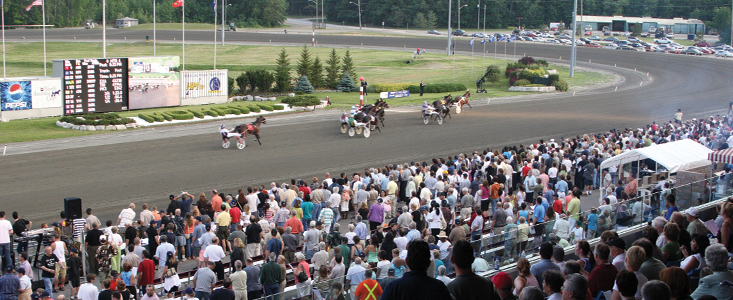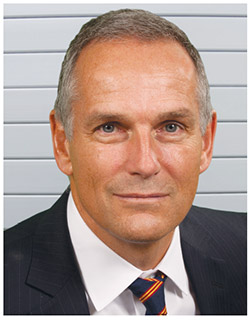Jim Lawson, formerly the Chairman and newly-appointed CEO of Woodbine Entertainment Group, has a long and accomplished association with the sport of horse racing. His father, the late Mel Lawson, was a highly successful and high-profile thoroughbred owner/breeder, the man behind Jim Dandy Stable.
Lawson is currently the Chairman of the Board of Governors of the Canadian Football League and has also served recently as the Commissioner of the CFL.
Lawson served over the course of his career as a Partner at Torys LLP and at Davies Ward Phillips & Vineberg LLP and as the Senior Vice President of XO Communications Canada. He was Co-Chair of the Finance and Real Estate Group at Torys LLP from 2001 – 2004. He has served on a number of public (Toronto Stock Exchange) boards including Algoma Steel Inc., Zargon Energy Trust and Countryside Power Income Fund. Lawson also serves as the Chairman of the Board of Stewards of the Jockey Club of Canada.
Born in Hamilton, Ontario, Lawson has an LLB from the University of Western Ontario and a Bachelor’s Degree (magna cum laude) in Economics from Brown University. He was also selected 120th overall by the Montreal Canadiens in the 1978 NHL Entry Draft.
By Chris Lomon
TROT: In a perfect world, if everything goes exactly as you’d hope, what does horse racing look like in Ontario in 20 years?
LAWSON: Woodbine Entertainment Group would take a leading role in helping two things to happen. First, harness and horse racing more broadly, would again hold a leading place in the hearts of Ontarians and be an important part of our sporting life – up there with baseball, football and even hockey. Second, the harness racing and breeding industry would be self-sufficient and independent of government funding as this would mean we were running our business according to strong, long-term, and predictable funding models. The bottom line is that you need horses for this to work. That’s at the core.
It’s absolutely critical that everyone involved in the industry has confidence in its stability beyond three and five-year breeding cycles. We simply cannot lose the grassroots identity of the industry. I’m very sincere about this. I love the industry and I love the people who are part of it.
TROT: Similarly, what would the future of Woodbine be in 20 years?
LAWSON: Ultimately, we envision the Woodbine and Mohawk sites as vibrant entertainment destinations that will be the centres of economic activity and new jobs and a leader in North American top-class racing for both breeds.
We also need to reach out to that next generation, to attract them to our great sport. It’s a challenge, the same as it is in the Canadian Football League (CFL). When you get to a CFL game, there are fireworks – a really different approach than ever before. You need to be entertaining, to provide people with a great experience, in new and exciting ways. We need to be bold. We need to create buzz.
It is such a luxury to have two great racing venues in Woodbine and Mohawk. There is really nothing better than being at Mohawk on a Saturday night. It’s a great atmosphere. It’s fun. We want people to know that. We’re striving to improve that game-day experience, so to speak.
LAWSON: It’s important to first understand how we got to where we are today. Over the past few years, significant changes have taken place across the horse racing and breeding industry in Ontario. Remember that it wasn’t long ago – only in 2012 – the Slots-at-Racetracks program was cancelled. When that happened we were forced to quickly re-evaluate and re-imagine how to sustain a significant industry – one that supported over 55,000 jobs. WEG and the industry had to change. And we did – we came together to make big changes. In that time, a number of leaders from different facets of the industry have worked hard to ensure everything that has occurred has been done with the sole purpose of benefitting the industry.
I recently joined the Board of OHRIA. It’s vital that we work in unison to create success in the industry. It’s a partnership that everyone benefits from. It was critical that our collective efforts were focused on that single goal, or else we wouldn’t be in as stable a position as we are today. For our part, all of Woodbine’s net proceeds are reinvested back into the industry,our facilities, our employees, and our local communities.
We’ve also learned – through both the Slots-at-Racetracks program as well as through the Woodbine Live plan – that there is a symbiotic relationship between gaming and horse racing. For those of us who have been part of the horse business, we’ve long known this to be true.
But through those failed programs, we all experienced it firsthand. Gaming provides predictable revenues to secure the purses for our internationally recognized events and helps to draw in the most talented drivers, jockeys, trainers and horses in the world. In fact, for the communities who host racing and breeding facilities and for racing fans, the correlation between racing and gaming is accepted and even celebrated. This link between gaming and racing needs to become part of the discussion. I think we have seen a major step forward in the relationship between horse racing and gaming. We have an opportunity to move forward on that. It’s a breath of fresh air. WEG is a racing and entertainment company and we know gaming plays an important role in how we will grow and flourish.
But as of today, the correlation between racing and gaming hasn’t yet been cemented in the minds of government decision makers. As many know, last year we entered into a short-term transitional arrangement with the province, where we receive funds to support the industry. This funding was critical to our survival. But this five-year plan will end soon, as it is due for review in 2017, and will end in 2019.
What this means is that the deadline is quickly approaching where we must secure long-term and predictable revenues to protect what we have today and maintain the positive impact of our existing business.
Once we do this, the future and all of its possibilities open up.
TROT: What do you mean by ‘protect what we have today and maintain the positive impact of our existing business’?
LAWSON: When we look closer at the statistics, it really is amazing to see the impact Woodbine and Mohawk have within their local communities, the broader industry, and within Ontario.
For example, Woodbine is a major employer and entertainment destination in Toronto. Locally, Woodbine is responsible for the employment of more than 7,500 people in Toronto. About 5,000 of those jobs are based on-site in Rexdale. That’s 10% of the total workforce in Rexdale – equal to one of every ten jobs in a community that has seen a 26% decline in jobs over the last 10 years.
The influence of WEG standardbred racing is far reaching. From an entertainment perspective, Woodbine attracts more than 6 million visitors every year, helping to preserve and promote a unique cultural experience. We have 118 dates at Mohawk this year, maybe more in an expanded meet in the future.
Highlights include Mohawk hosting the $1 million Pepsi North America Cup final on June 20, the Canadian Pacing Derby and Metro Pace on September 5, the Maple Leaf Trot on September 19 and Woodbine is proud to host the Breeders Crown once again this year on October 24.
Our financial impact is also significant. OLG now contributes approximately $15 million to Toronto every year through the Slots at Woodbine operations, as well as the annual taxes that go to Toronto and Ontario.
TROT: What exactly is the vision for the Woodbine site?
LAWSON: Looking to the future, WEG’s intention is to move forward with a comprehensive development of both Woodbine and Mohawk, which is complementary to our core horse racing and breeding business.
As a racing and entertainment business, our vision includes many different potential elements that would add to our existing properties. These may include any number or combination of new performance spaces, restaurants, meeting spaces, or hotel rooms. Gaming will help make this future come to life.
But – and it is important to understand this point – right now, both the City of Toronto and the province are managing processes that will determine what the future of the Woodbine and Mohawk sites may be. We, at WEG, have to follow the processes through to the end to understand the scope and parameters the city and province want to set for what can be developed.
TROT: Who needs to lead the efforts to get you where you envision you can go?
LAWSON: As they say – it’ll take a village. We will need players from provincial and municipal governments to agree that the impact Woodbine and Mohawk makes is invaluable and worth protecting. From there, we will need decision makers from across government, industry, and our communities to come together and agree that the Woodbine site is a logical and exciting location for future development. With 600+ acres of space within the city limits it’s hard to imagine a better blank slate for creative and smart city building.
TROT: Why do you care about the industry? Why does it matter?
LAWSON: Beyond the very real impact on jobs, the economy and the industry we’ve already discussed, there is a very simple personal reason as well. I have spent my life in the racing industry – it has formed who I am and the values I have and share with my children. It is a privilege to have had this experience. Those in the industry know that it’s very hard to describe the level of passion and devotion of those who work hard to make it their livelihood – horse handlers, trainers, breeders – but my experience has permitted me to witness it first-hand. This passion drives WEG’s focus on ensuring the industry succeeds.
We have established WEG Cares (an initiative where WEG works with community organizations and causes that contribute to local neighbourhoods), but it is something that extends far beyond our community partners. WEG Cares is also about the people in the horse racing industry. That’s a very important message we want conveyed to the people that are part of our great sport.

 TROT: What is required to get there?
TROT: What is required to get there?



I don't know Jim Lawson but
I don't know Jim Lawson but this was a great interview, very positive and upbeat. He sounds like the right man at the right time with a vision and an ability to articulate it. I like the fact he is a lifer in this industry, in order to remain in it we have to be as tough as we want our horses to be. Better days ahead.